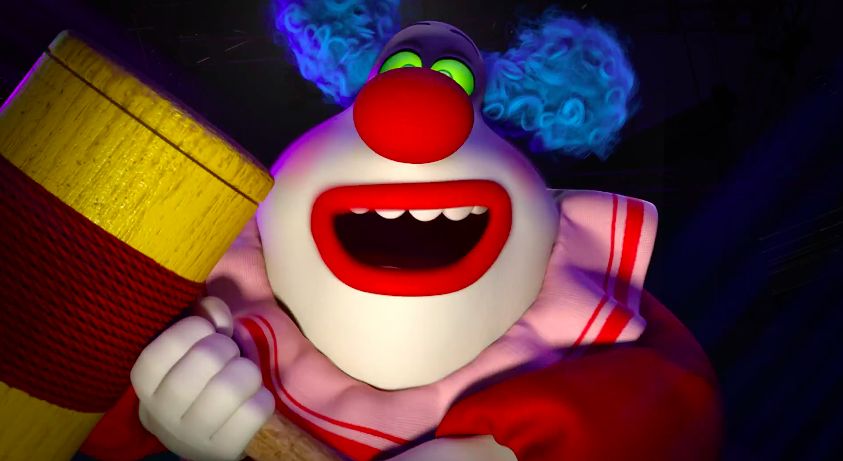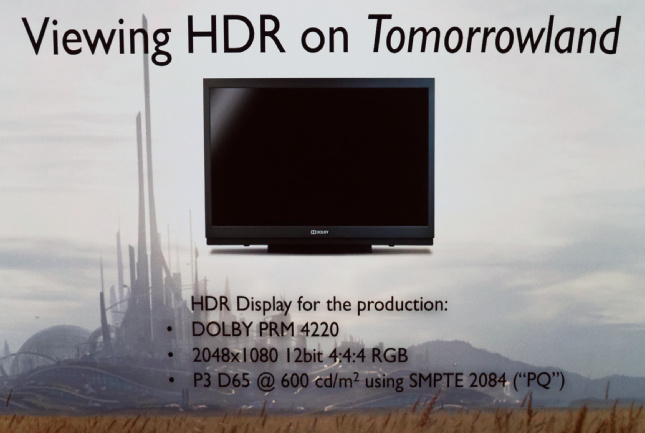Unfortunately the joys of torrential rain and Monday morning Amsterdam traffic meant that we missed the very beginning of the Pixar/ILM keynote.
The discussion when we sneaked in was about the use of different levels of brightness available once you move to Dolby Vision as well as the wide colour gamut. Pixar decided early on to try to exploit these features in the movie “Inside Out”. The movie is based on the thoughts of a young girl and viewers see the “real world” and also “inside her head”.
Pixar experimented with a very contrast reduced look for the “real world” scenes, but finally settled on 48 nits with “washed out” blacks for those scenes then full black with more peak brightness at 62 nits for the scenes “inside”, which are intended to be much more dramatic. The highest brightness in Dolby Vision cinemas is 108 nits, but this was only used in occasional scenes, generally for a few frames.
For example, the director used the highest peak brightness for the moments when the “anger” character is really “exploding”. One of the concepts of the movie is that ideas and memories are in spheres and “key idea” spheres were boosted in brightness to make them stand out from others.
Some scenes are intended to show abstract thought and here the background was black. The ambient lighting in Dolby Vision theatres is very close to black and so the frame of the picture almost disappears. That was an effect that was unexpected, but added to the immersiveness of those scenes.
One area where lighting was very carefully used and controlled was in the “subconscious” scenes. The writer previously saw these scenes at a local cinema and can confirm that on the display at IBC (using Christie 6P laser projectors at IBC, although without the full Dolby Vision HDR experience) colours shown looked great compared to the standard cinema. Although advertised as using Rec. 2020, Pixar did not exactly use the full gamut. The Rec 2020 gamut fits in a DCI container which is based on XYZ so P3 or Rec 2020 gamut recording is no problem.
 Inside Out used HDR to create special effects during the “Subconscious” scene
Inside Out used HDR to create special effects during the “Subconscious” scene
Exploiting the HDR, the directors went for a “Velvet painting” effect during the “subconscious” scenes and that was very effective on the Christie projectors.
Directors are said to be very excited to use the wide gamut available and the big premiere was shown at the El Capitan cinema in Hollywood where it was shown with HDR & WCG in Dolby Vision.
What followed during the keynote was a high intensity discussion of the workflow considerations. Given this writer’s limited knowlege of production formats, some details may have been missed – apologies.
One key decision was to have a very consistent platform for the data. The PQ curve “ST 2084” allowed very accurate brightness without clipping and this was really appreciated.
DCI IMBs in cinemas had no problem with content created originally for Dolby Vision and the movie “worked fine” in DCI IMBs by using a subset of the chromaticity and brightness within ST2084. A Dolby Pulsar reference monitor was used – with the master at 12 bits of colour depth (the archive is “even higher”) However, there is a lot of 10 bit hardware around in distribution, so careful dithering is needed to ensure that there are no strange artefacts when the 12 bit content is shown on those systems.
Next there was a discussion between Dominic Glynn and Rick Sayre of Pixar and ILM’s Jay (Jeroen) Schulte, which started with a description of the making of Tomorrowland.
 The Tomorrowland team had to develop a workflowTomorrowland was the first movie to use Dolby Vision and Schulte said that there is a moment when Dorothy “opened the door to technicolor” in the Wizard of Oz. The idea was that Tomorrowland should deliver the same shift in quality. Schulte said that HDR capture has been ahead of display and delivery for a long time and the arrival of Dolby Vision really helps to get them back in sync.
The Tomorrowland team had to develop a workflowTomorrowland was the first movie to use Dolby Vision and Schulte said that there is a moment when Dorothy “opened the door to technicolor” in the Wizard of Oz. The idea was that Tomorrowland should deliver the same shift in quality. Schulte said that HDR capture has been ahead of display and delivery for a long time and the arrival of Dolby Vision really helps to get them back in sync.
Disney made a big camera test to try out different systems before it started production. When the project started, a 4K HDR projector was not available in the market, so the group decided to use four tiled 2K projectors to do the grading and review, rather than using a traditional 100 nit grading display. This was not true HDR – the black went up too, but the high brightness was seen as good. As an experiment, Disney also did tests of HFR at 48fps – but they decided they didn’t like it and “it didn’t look cinematic” (that brought some agreement from others in the hall). There was some viewing on an experimental 5K nit display.
There was a real question during production about what you could you do HDR with in post production? This needed careful planning and Disney used Joust as a “digital clearing house” – this was seen as an important early decision.
The winner of the camera test was Sony’s F65 which could record 8K OpenEXR and Sony S-Gamut was used for capture. F65 Raw was very good to use – you could always go back to the RAW files to make corrections or fixes and again this early decision was regarded as a good one. Production had access to all the raw materials with a quick turnaround.
The point was made that camera vendors sometimes change their log-lin settings without notice or warning, so it’s worth fixing it for a project – you don’t want changes during the production process.
Dailies were considered expendable, but, in reality, people get used to a particular set of colours that they have seen in the dailies. HDR was watched on the Dolby PRM4220 monitor at D65 with just 2K x 1K resolution and with brightness of 600 cd/m² and using the SMPTE-2084 – PQ EOTF.
Looking at white point, there is a choice of daylight locus these days, and you can use changed values for a particular purpose. (at this point my notes were just a string of acronyms!) ILM likes the OCIO (ColorOpenIO) to progate PQ graded content and ILM used Avid QP and the DNxHD codec. Nuke was used for compositing.
As TomorrowLand was the first Dolby Vision production, there was no pre-defined workflow. In this case, the HDR grade was made from the DCI grade with a P3 gamut at D65 – with much checking at every stage to make sure everything looked OK.
Schulte said that when things went wrong, there is often a tendency to jump to something complicated when often the solutions were quite simple things.
Working with PQ, the best way is using 12 bit Full range – as with all video and codecs, there are lot of very slightly different formats (e.g. 16-4079 or 16-4076 as valid values) and that could be tricky.
Schulte said “Don’t composite with PQ” (later it was stated that everything was done in SLog), just use it for delivery. He loves the idea of precise brightness with very clearly defined values for different code levels. He said that ILM built a “bridge of toothpicks” based on the brightness – you need to make sure that you don’t break the bridge!
Working in HDR, you don’t really think about black or white – you think more “photographically”. You start by picking a grey point that you want to use then finesse over or under from there (it sounds like the Ansel Adams zone system to us! Man. Ed.)
The grading started with a digital cinema grade. Stretching the content meant “Taking the clamps off”. The effect can be very dramatic – you can see the “sparkle in the actors eyes” an effect that you’ve simply never seen before in a movie. The technology is in its infancy, so there are many new things to explore.

A point was made that “grading information” is not “metadata” – it’s editorial intent. When the creatives look at the dailies – they will often get them to a particular look and that is what they really want to see on the final content.
Advice was also given “Don’t change the colour space during rendering as it changes textures”. This can have surprising and unpredictable effects. While “More pixels costs more”, 2K with HDR can look like 4K because of the extra contrast on edges and in details. The panel ageed that “you see HDR, you get it”
However, the peak brightness needs to be thought about carefully “With high brightness comes high responsibility….” was a quote that we like.
HDR “pop” and sparkle seems to be more important than WCG, but for some content the expanded colour palette is a big advantage. HFR is really not seen as important by many in the movie business.

